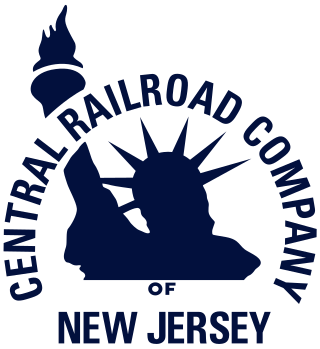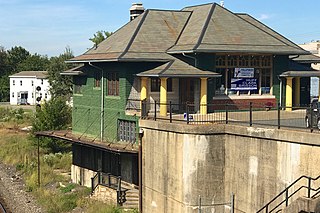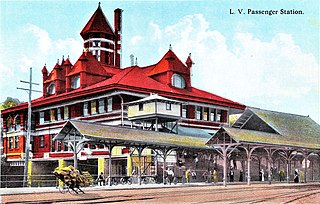
The Delaware, Lackawanna and Western Railroad, also known as the DL&W or Lackawanna Railroad, was a U.S. Class 1 railroad that connected Buffalo, New York, and Hoboken, New Jersey, and by ferry with New York City, a distance of 395 miles (636 km). The railroad was incorporated in Pennsylvania in 1853, and created primarily to provide a means of transport of anthracite coal from the Coal Region in Northeast Pennsylvania to large coal markets in New York City. The railroad gradually expanded both east and west, and eventually linked Buffalo with New York City.
The Lehigh Valley Railroad was a railroad in the Northeastern United States built predominantly to haul anthracite coal from the Coal Region in Northeastern Pennsylvania to major consumer markets in Philadelphia, New York City, and elsewhere.

The Central Railroad of New Jersey, also known as the Jersey Central, Jersey Central Lines or New Jersey Central, was a Class I railroad with origins in the 1830s. It was absorbed into Conrail in April 1976 along with several other prominent bankrupt railroads of the Northeastern United States.

Conrail, formally the Consolidated Rail Corporation, was the primary Class I railroad in the Northeastern United States between 1976 and 1999. The trade name Conrail is a portmanteau based on the company's legal name. It continues to do business as an asset management and network services provider in three Shared Assets Areas that were excluded from the division of its operations during its acquisition by CSX Corporation and the Norfolk Southern Railway.

The Lehigh and Hudson River Railway (L&HR) was the smallest of the six railroads that were merged into Conrail in 1976. It was a bridge line running northeast–southwest across northwestern New Jersey, connecting the line to the Poughkeepsie Bridge at Maybrook, New York, with Easton, Pennsylvania, where it interchanged with various other companies.
The Belvidere-Delaware Railroad was a railroad running along the eastern shore of the Delaware River from Trenton, New Jersey north via Phillipsburg, New Jersey to Manunka Chunk, New Jersey. It became an important feeder line for the Lehigh Valley Railroad's join to the Central Railroad of New Jersey, which was constructed into Phillipsburg, New Jersey, at about the same time. This connected Philadelphia and Trenton, New Jersey at one end of the shortline railroad to the rapidly growing lower Wyoming Valley region, and via the Morris Canal or the CNJ, a slow or fast connection to New York City ferries crossing New York Harbor from Jersey City, New Jersey.
North Pennsylvania Railroad was a railroad company which served Philadelphia, Montgomery County, Bucks County and Northampton County in Pennsylvania. It was formed in 1852, and began operation in 1855. The Philadelphia and Reading Railway, predecessor to the Reading Company, leased the North Pennsylvania in 1879. Its tracks were transferred to Conrail and the Southeastern Pennsylvania Transportation Authority (SEPTA) in 1976.

Union is a NJ Transit railroad station in Union, New Jersey. Located on the Conrail Lehigh Line, Union is served by Raritan Valley Line trains that travel between Newark Penn Station and Raritan. There is also limited service to and from High Bridge and New York Penn Station and one morning train to Hoboken Terminal. The physical structures of the station are owned by NJ Transit; however, the land remains the property of Conrail Shared Assets Operations, which is in turn owned by Norfolk Southern Railway and CSX Corporation.
The Lehigh Division is a major freight low grade rail line owned and operated by the Reading Blue Mountain and Northern Railroad in the U.S. state of Pennsylvania that runs from Lehighton, Pennsylvania to Dupont, Pennsylvania; it originally ran from Lehighton to Mehoopany, Pennsylvania. The Lehigh Division was formed in 1993 by Conrail from the Lehigh Line, officially the former main line of the Lehigh Valley Railroad (LVRR) that has absorbed former Central Railroad of New Jersey (CNJ) main line trackage and former Lehigh and Susquehanna Railroad (L&S) main line trackage into its system under Conrail; the Lehigh Line today is owned by the Norfolk Southern Railway and connects to the Lehigh Division at Lehighton.
The Lehigh and Susquehanna Railroad is a defunct railroad that operated in eastern Pennsylvania during the 19th and 20th centuries. The company was a subsidiary of the Lehigh Coal & Navigation Company (LC&N). For much of its lifetime, however, it was leased by the Central Railroad of New Jersey.

The Lehigh Line is a railroad line in Central New Jersey, Northeastern Pennsylvania, and the Lehigh Valley region of eastern Pennsylvania. It is owned and operated by the Norfolk Southern Railway. The line runs west from the vicinity of the Port of New York and New Jersey in Manville, New Jersey via Conrail's Lehigh Line to the southern end of Wyoming Valley's Coal Region in Lehigh Township, Pennsylvania.

Phillipsburg Union Station is an active railroad station museum, in Phillipsburg, New Jersey, United States, at 178 South Main Street. Opened in 1914, Union Station was built by the Delaware, Lackawanna & Western Railroad (DL&W) and shared with the Central Railroad of New Jersey (CNJ) and was situated where the lines merged before the bridge crossing the Delaware River. Designed by Frank J. Nies, the architect who produced many of DL&W stations now listed state and federal registers of historic places, the 2+1⁄2 story, 3 bay brick building is unusual example of a union station and a representation of early 20th century Prairie style architecture. The Phillipsburg Union Signal Tower, or PU Tower, is nearby, also restored to its original form, and available for tours.

Allentown was a train station in Allentown, Pennsylvania. It was opened by the Lehigh Valley Railroad in 1890 and closed in 1961. The building was demolished in 1972. The station was located one block west of the Central Railroad of New Jersey's Allentown station.

Flemington Junction station is a defunct Lehigh Valley Railroad station in Flemington Junction, New Jersey. It was located at the junction of the Lehigh Valley's Flemington Branch and Main Line, although the name predated the opening of the branch by eight years.
The Southern Central Railroad is a defunct railroad which operated in the state of New York in the nineteenth century. The company's line ran from Fair Haven, New York, on the south shore of Lake Ontario, to Athens, Pennsylvania, in the Southern Tier and just over the border into Pennsylvania. The company was incorporated in 1865 and became part of the Lehigh Valley Railroad system in 1895. Most of its line was abandoned by the Lehigh Valley Railroad between 1937–1979; the portion between Harford Mills, New York, and Owego, New York, is owned by the Tioga County Industrial Development Agency and operated by the Owego and Harford Railway.
The Main Line of the Reading Company was a railway line in the U.S. state of Pennsylvania. The 88-mile-long (142 km) main line ran from Philadelphia to Pottsville, Pennsylvania, following the Schuylkill River.
The Wilmington and Northern Branch is a partially-abandoned railway line in the states of Delaware and Pennsylvania. It was constructed between 1869 and 1870 by the Wilmington and Reading Railroad, a predecessor of the Wilmington and Northern Railroad. At its fullest extent it connected Reading, Pennsylvania, with Wilmington, Delaware. The Philadelphia and Reading Railway leased the line in 1900. With the Reading Company's bankruptcy and the creation of Conrail in 1976 the line's ownership fragmented, and the section between Coatesville, Pennsylvania, and Birdsboro, Pennsylvania, has been abandoned.
The Port Reading Secondary, also known as the Port Reading Branch, is a railway line in New Jersey. It runs 16.0 miles (25.7 km) from a junction with the Lehigh Line in Bound Brook, New Jersey, to Port Reading, New Jersey, on the Arthur Kill. Originally built by the Port Reading Railroad and part of the Reading Company system, today the line belongs to Conrail Shared Assets Operations (CSAO).
The Lehigh and Lackawanna Railroad was a railway company in the United States. It was incorporated in 1864 and opened its initial line between Bethlehem, and Chapman, Pennsylvania, in 1867. At its peak, the company's line extended 25.3 miles (40.7 km) from Bethlehem to Wind Gap, Pennsylvania. The company and its line became part of the Lehigh and New England Railroad in 1904. Part of the line was abandoned in 1962; the remainder is part of the Norfolk Southern Railway's Cement Secondary.
The Catasauqua Branch was a short railway line in Lehigh and Northampton Counties in the state of Pennsylvania. It was part of the Lehigh and New England Railroad and ran from a point south of Bath to Catasauqua, where it interchanged with the Central Railroad of New Jersey and Lehigh Valley Railroad. The line opened in 1914 and was partially abandoned in 1961 on the Lehigh and New England Railroad's bankruptcy and closure. Conrail abandoned the remainder in the 1990s.









